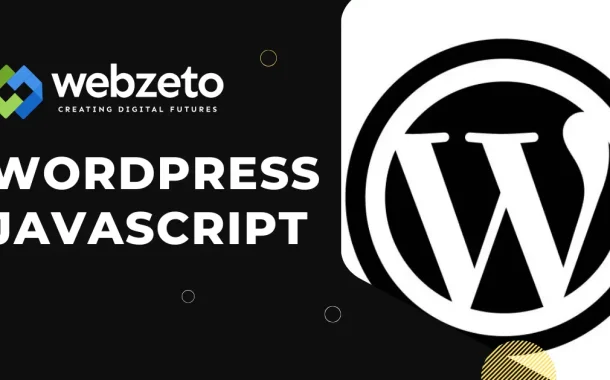Javascript allows websites to be more dynamic and responsive. Developers use JavaScript to create rich interfaces and improve website performance. With the rise of single-page applications and frameworks like React and Vue.js, JavaScript skills are more valuable than ever.
Table of Contents
Table of Contents
JavaScript in WordPress Themes
JavaScript is crucial for making WordPress themes interactive and dynamic. It enables features like sliders, pop-up modals, and AJAX-based content loading, which enhance the user experience. To add JavaScript to your theme, you typically use WordPress functions to ensure scripts are loaded correctly and only when needed. This process helps avoid conflicts with other themes or plugins.
To include JavaScript in your theme, you place your JavaScript files in a dedicated js directory within your theme folder. Using descriptive names for your scripts is essential to prevent naming conflicts. Instead of directly embedding scripts in your HTML, you use WordPress’s wp_enqueue_script() function. This method allows you to manage script dependencies and loading order efficiently.
When enqueuing scripts, you specify a handle for your script, the file path, dependencies like jQuery, and whether the script should load in the footer for better performance. This organized approach helps maintain a clean and manageable codebase. It also ensures that scripts are only loaded when necessary, improving the website’s performance.
JavaScript in WordPress Plugins
JavaScript is a vital component in WordPress plugins, enabling dynamic and interactive functionalities that enhance user experience. When developing plugins, you often need to add custom JavaScript to perform tasks such as form validation, dynamic content updates, and AJAX interactions. To properly include JavaScript in your plugin, you use WordPress’s enqueuing functions to ensure scripts are loaded correctly and efficiently.
The process of adding JavaScript to a plugin involves enqueuing scripts in your plugin file. This means you specify the script file, its dependencies, and where it should be loaded in the HTML document. Using the wp_enqueue_script() function is the standard practice. It helps manage dependencies and prevents conflicts with other scripts, ensuring smooth functionality.
For instance, if your plugin needs jQuery, you can specify it as a dependency so that WordPress loads jQuery before your custom script. Additionally, loading scripts in the footer can improve page load times by allowing the HTML content to load first. This practice enhances performance and provides a better user experience.
Using jQuery in WordPress
Using jQuery in WordPress is straightforward and enhances the interactivity and user experience of your site.
Enqueuing jQuery in WordPress Themes
To use jQuery in your WordPress theme, you need to enqueue it. This ensures jQuery is loaded correctly. Modify your theme’s functions.php file to add jQuery. This makes sure it is available for any custom scripts you want to use. Loading scripts in the footer improves performance. It helps your website load faster.
Enqueuing jQuery in WordPress Plugins
In a WordPress plugin, the process is similar. Add a function in your plugin’s main file to enqueue jQuery. This ensures jQuery is loaded whenever your plugin is active. Properly enqueuing prevents conflicts and improves functionality. Specify dependencies correctly to avoid issues. This makes your plugin more stable.
Writing jQuery Code
When writing jQuery code, use WordPress’s no-conflict mode. Write jQuery instead of $ to avoid issues. This keeps your code compatible with other scripts. Always test your jQuery code on different browsers and devices. This ensures it works well for all users. Using jQuery ensures your scripts run smoothly. It helps maintain a stable environment.
WordPress REST API and JavaScript
WordPress REST API allows JavaScript applications to interact with WordPress data. It provides endpoints for accessing posts, users, and other content. To use the REST API in JavaScript, fetch data from these endpoints using JavaScript’s fetch() function. This enables dynamic and real-time updates to your website.
Making API Calls with JavaScript
To make API calls with JavaScript, use the fetch() function to retrieve data from WordPress endpoints. Construct the URL for the desired endpoint, then fetch the data asynchronously. Process the response using JavaScript to display the data dynamically on your website. This enables seamless integration of WordPress content with JavaScript applications.
Handling Responses and Errors
When making API calls with JavaScript, handle responses and errors appropriately. Check the status of the response to ensure it’s successful. Use conditional statements to handle different response scenarios. Display data to users if the response is successful. Handle errors gracefully by providing informative messages to users. This enhances the user experience and ensures smooth interaction with WordPress data.
JavaScript Frameworks and Libraries
JavaScript frameworks and libraries provide powerful tools for building dynamic web applications. Frameworks like React and Vue.js, and libraries like jQuery, offer pre-built components and utilities that streamline development.
React and WordPress
React is a popular JavaScript library for building user interfaces. With the rise of headless WordPress and the Gutenberg editor, React has gained traction in WordPress development. React components can be integrated into WordPress themes and plugins, allowing for highly customizable and interactive user experiences.
Vue.js and WordPress
Vue.js is another JavaScript framework known for its simplicity and versatility. It offers a progressive approach to building user interfaces and is well-suited for small to medium-sized projects. Vue.js can be seamlessly integrated with WordPress, providing developers with a flexible tool for creating dynamic web applications.
Other Popular Libraries and Frameworks
In addition to React and Vue.js, there are other JavaScript libraries and frameworks worth exploring. Libraries like lodash offer utility functions for common programming tasks, while frameworks like Angular provide comprehensive solutions for building complex web applications.
Gutenberg Block Development
Gutenberg introduces a block-based approach to WordPress content editing and customization. Block development involves creating custom blocks to extend the functionality of the WordPress editor.
Creating Custom Blocks with JavaScript
To create custom blocks with JavaScript, you utilize the Gutenberg Block API. This API provides a set of tools and utilities for building blocks, including block registration, block attributes, and block rendering. Custom blocks are typically developed using React components, which allows for dynamic and interactive content editing experiences.
Advanced Block Development Techniques
Advanced block development techniques involve implementing features like dynamic attributes, block styles, and block transformations. Dynamic attributes enable blocks to react to user input and update dynamically. Block styles allow for customizing the appearance of blocks using CSS. Block transformations enable converting one block type into another, providing flexibility in content creation.
Testing and Deploying Custom Blocks
Testing custom blocks is essential to ensure they function as expected across different environments and scenarios. WordPress provides tools like the Gutenberg plugin for testing blocks in a local development environment. Once tested, custom blocks can be deployed to production sites using various methods, such as manual installation or distribution through the WordPress plugin repository.
Localization and Internationalization
JavaScript translatable involves preparing your scripts for translation into different languages. Use localization functions provided by WordPress, such as wp_localize_script(), to pass translation strings from PHP to JavaScript.
Using wp_localize_script()
The wp_localize_script() function allows you to inject localized data into your JavaScript files. This data typically includes translation strings and other dynamic content that needs to be available in JavaScript. By using this function, you make your JavaScript code translatable and adaptable to different languages and locales.
Best Practices for Localization
When localizing JavaScript, follow best practices to ensure effective translation. Use meaningful and descriptive text domain identifiers for your translation strings. This helps translators identify the context of each string. Additionally, provide clear instructions for translators and maintain consistency in your codebase to streamline the translation process and improve the quality of translations.
Ensuring Multilingual Support
Localization and internationalization are crucial for ensuring your WordPress website can be accessed and understood by users worldwide. By properly localizing your JavaScript content and implementing internationalization techniques, you create a more inclusive and accessible user experience for a global audience. Regularly test your localized content to ensure accuracy and compatibility across different languages and locales.
Debugging and Testing JavaScript
Debugging JavaScript involves identifying and fixing errors or issues in your code. Utilize browser developer tools like Chrome DevTools or Firefox Developer Tools to inspect JavaScript code, set breakpoints, and track variables.
Writing Unit Tests for JavaScript
Unit testing involves testing individual units or components of your JavaScript code in isolation. Use testing frameworks like Jest or Mocha along with assertion libraries like Chai to write and run unit tests for your JavaScript functions and modules. Writing comprehensive unit tests helps ensure the reliability and correctness of your codebase.
End-to-end testing with JavaScript
End-to-end testing involves testing the entire flow of your application, including user interactions and backend processes. Tools like Cypress or Selenium WebDriver allow you to automate end-to-end tests for your JavaScript applications. By simulating user actions and verifying expected outcomes, you can identify bugs and ensure the overall functionality and performance of your application.
Ensuring Code Quality
Maintaining code quality is essential for reliable and maintainable JavaScript applications. Use linting tools like ESLint or JSHint to enforce coding standards and detect potential issues in your code. Additionally, adopt code review practices within your development team to ensure consistency and adherence to best practices.
Performance Optimization
Minimizing and compressing JavaScript files reduces their size, improving page load times. Use tools like UglifyJS or Terser to minify JavaScript code by removing unnecessary whitespace, comments, and renaming variables. Additionally, enable gzip compression on your web server to further reduce file size and enhance performance.
Reducing JavaScript Load Times
Reducing JavaScript load times involves optimizing how and when scripts are loaded on your website. Load critical JavaScript files asynchronously or defer their execution to improve initial page load times. Lazy loading of non-essential scripts allows them to be fetched and executed only when needed, reducing unnecessary network requests and improving overall performance.
Best Practices for Performance
Follow best practices to optimize JavaScript performance effectively. Minimize DOM manipulation and avoid synchronous XMLHttpRequests (XHR) to prevent rendering delays. Use efficient algorithms and data structures to optimize JavaScript code execution. Implement caching strategies to store and reuse frequently accessed data, reducing server load and improving response times.
Monitoring and Tuning Performance
Regularly monitor your website’s performance using tools like Google PageSpeed Insights or Lighthouse. Analyze performance metrics such as page load times, time to interact, and resource utilization. Identify bottlenecks and areas for improvement, then implement optimizations accordingly.
FAQs
Q. Can I use JavaScript directly within WordPress content?
Yes, you can use JavaScript within WordPress content, but it’s important to be cautious. Avoid inline JavaScript for security and performance reasons. Instead, consider enqueuing JavaScript files properly.
Q. How can I ensure compatibility with older browsers when using JavaScript in WordPress?
To ensure compatibility with older browsers, consider using polyfills or fallbacks for modern JavaScript features not supported by older browsers. Additionally, thoroughly test your JavaScript code across different browsers and devices.
Q. Is it possible to integrate third-party JavaScript libraries into WordPress?
Yes, it’s possible to integrate third-party JavaScript libraries into WordPress themes or plugins. Use the wp_enqueue_script() function to load external JavaScript files, and ensure proper initialization and usage within your WordPress environment.
Q. What are some common security risks associated with JavaScript in WordPress?
Common security risks include Cross-Site Scripting (XSS) attacks, where malicious JavaScript code is injected into web pages, and Cross-Site Request Forgery (CSRF) attacks, where unauthorized actions are performed on behalf of authenticated users. Sanitize user input and validate data to mitigate these risks.
Q. How can I optimize JavaScript performance in a WordPress environment?
Optimize JavaScript performance by minimizing and compressing files, reducing load times through asynchronous loading and lazy loading techniques, and following best practices for efficient code execution. Regularly monitor performance metrics and tune your JavaScript code accordingly.
Conclusion
JavaScript plays a crucial role in extending the functionality and interactivity of WordPress websites. Whether you’re developing themes, plugins, or custom blocks, understanding JavaScript is essential for creating dynamic and engaging user experiences. By leveraging JavaScript frameworks and libraries like React and Vue.js, developers can build modern and feature-rich applications within the WordPress ecosystem.
Furthermore, proper utilization of JavaScript in WordPress involves following best practices for performance optimization, security, and internationalization. By enqueuing scripts correctly, handling translations effectively, and implementing robust security measures, you can ensure that your WordPress site is both efficient and accessible to a global audience.














